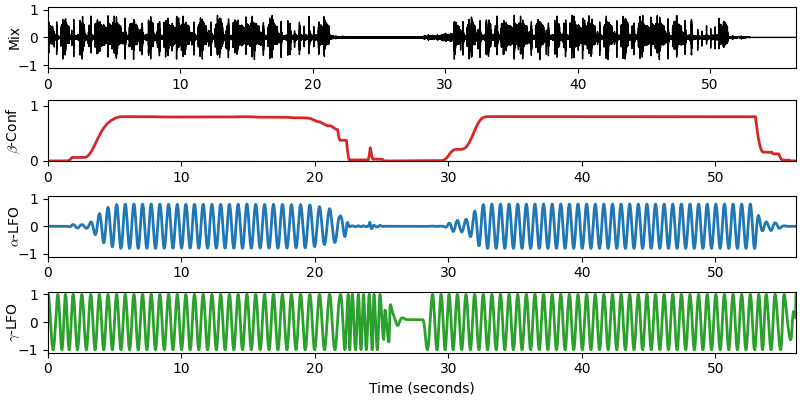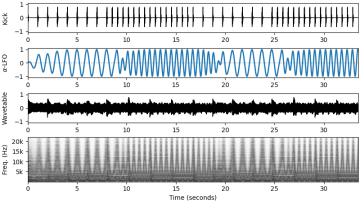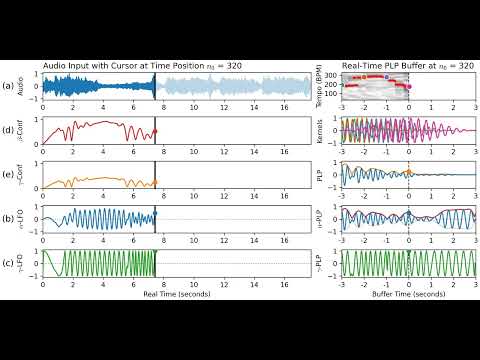A Real-Time Approach for Estimating Pulse Tracking Parameters for Beat-Synchronous Audio Effects

Peter Meier, Simon Schwär, Meinard Müller
This website is related to the following publication:
- Peter Meier, Simon Schwär, and Meinard Müller
A Real-Time Approach for Estimating Pulse Tracking Parameters for Beat-Synchronous Audio Effects
In Proceedings of the International Conference on Digital Audio Effects (DAFx): 314–321, 2024. Demo@inproceedings{MeierSM24_RealTimePulseParameters_DAFX, author = {Peter Meier and Simon Schw{\"a}r and Meinard M{\"u}ller}, title = {{A} Real-Time Approach for Estimating Pulse Tracking Parameters for Beat-Synchronous Audio Effects}, booktitle = {Proceedings of the International Conference on Digital Audio Effects ({DAFx})}, address = {Guildford, Surrey, {UK}}, year = {2024}, pages = {314--321}, url-demo = {https://audiolabs-erlangen.de/resources/MIR/2024-DAFx-RealTimePLP} }
Abstract
Predominant Local Pulse (PLP) estimation, an established method for extracting beat positions and other periodic pulse information from audio signals, has recently been extended with an online variant tailored for real-time applications. In this paper, we introduce a novel approach to generating various real-time control signals from the original online PLP output. While the PLP activation function encodes both predominant pulse information and pulse stability, we propose several normalization procedures to discern local pulse oscillation from stability, utilizing the PLP activation envelope. Through this, we generate pulse-synchronous Low Frequency Oscillators (LFOs) and supplementary confidence-based control signals, enabling dynamic control over audio effect parameters in real-time. Additionally, our approach enables beat position prediction, providing a look-ahead capability, for example, to compensate for system latency. To showcase the effectiveness of our control signals, we introduce an audio plugin prototype designed for integration within a Digital Audio Workstation (DAW), facilitating real-time applications of beat-synchronous effects during live mixing and performances. Moreover, this plugin serves as an educational tool, providing insights into PLP principles and the tempo structure of analyzed music signals.
Case Studies
The following audio example demonstrates several use cases of the introduced control signals in a popular music mix. All control signals in the example have been generated with the real-time algorithm using a downmix of drums, vibraphone and clavinet as an input signal. For a closer examination of the individual effects, see the individual case studies below.

Case Study 1: Volume Control with beta-Confidence
In this example, we use the beta-confidence to directly control the volume parameter of the "High Strings Pad" channel.
The reduced confidence in the middle section without a stable beat leads to a reduction in volume of around 6 dB.
For better isolation of the effect, only the drums and pad are audible in the excerpt below.

Case Study 2: Noise Gate with alpha-LFO
To show a use case for the alpha-LFO, we trigger a noise gate with this control signal, generating a shaker-like effect that is only present in stable beat parts.
We use a look-ahead of 0.32 seconds to shift the peaks of alpha-LFO to the offbeats in this 93 bpm example track.
For better isolation of the effect, only the drums and shaker are audible in the excerpt below.

Case Study 3: Rhythmic Panning with gamma-LFO
We use gamma-LFO to modulate the pan parameter for the vibraphone and plucked synth channels, so that each played 8th note alternates between the left and right channel.
Note how the gamma-LFO synchronizes quickly with the vibraphone entrance at the end of the middle section without a stable beat.
For better isolation of the effect, only the drum, vibraphone and plucked synth are audible in the excerpt below.

Audio Examples for Real-Time PLP Control Signals

In this example, we use a real-time PLP system to modulate the cutoff frequency of a low-pass filter, automatically shaping the sound of instruments such as bass or piano in a rhythmically interesting way. In another example, we utilize our system to modulate the position of a wavetable synthesizer in real-time.
Control Signal Animation
An audio excerpt featuring: (a) Audio input and control signals, (b) beta-Conf, (c) gamma-Conf, (d) alpha-LFO, and (e) gamma-LFO. The black cursor indicates the current time position. The right side of the figure displays the inner state of the PLP buffer at that time position.
Acknowledgments
This work was funded by the Deutsche Forschungsgemeinschaft (DFG, German Research Foundation) under Grant No. 500643750 (MU 2686/15-1). The International Audio Laboratories Erlangen are a joint institution of the Friedrich-Alexander-Universität Erlangen-Nürnberg (FAU) and Fraunhofer Institute for Integrated Circuits IIS.


